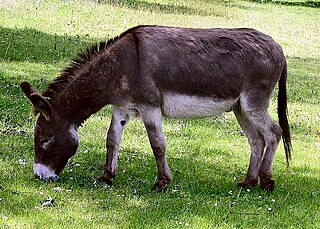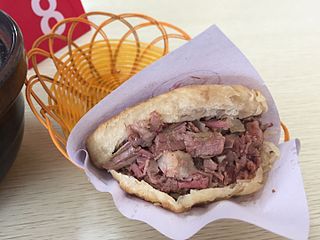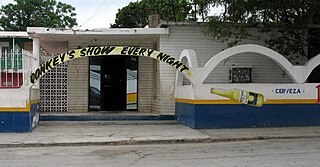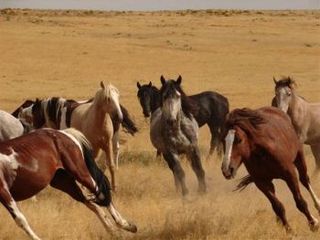 W
WThe donkey or ass is a domesticated member of the horse family, Equidae. The wild ancestor of the donkey is the African wild ass, E. africanus. The donkey has been used as a working animal for at least 5000 years. There are more than 40 million donkeys in the world, mostly in underdeveloped countries, where they are used principally as draught or pack animals. Working donkeys are often associated with those living at or below subsistence levels. Small numbers of donkeys are kept for breeding or as pets in developed countries.
 W
WThere are many cultural references to donkeys, in myth, folklore and religion, in language and in literature.
 W
WThe African wild ass or African wild donkey is a wild member of the horse family, Equidae. This species is believed to be the ancestor of the domestic donkey, which is usually placed within the same species. They live in the deserts and other arid areas of the Horn of Africa, in Eritrea, Ethiopia and Somalia. It formerly had a wider range north and west into Sudan, Egypt, and Libya. About 570 individuals exist in the wild.
 W
WThe donkey burger is a kind of sandwich commonly eaten in Baoding and Hejian, Hebei Province, China, where it is considered a local specialty, though it may also be found in other parts of China, particularly in northeastern China. Chopped or shredded donkey meat or offal is placed within a huǒshāo or shao bing, a roasted, semi-flaky bread pocket, and eaten as a snack or as part of a meal. Hejian style typically serves the meat cold in a warm huoshao while Baoding style serves the meat hot, they both often include green chili-pepper and cilantro leaves. Donkey burger is a popular street food and can also be found on the menus of high-end restaurants.
 W
WDonkey milk is the milk from the domesticated donkey (Equus asinus). It has been used since antiquity for cosmetic purposes as well as infant nutrition.
 W
WDonkey rides are a traditional feature of seaside resorts in the United Kingdom. Children are allowed to ride donkeys on a sandy beach for a fee in summer months while on holiday, normally led in groups at walking pace. Typically, the donkeys used to have their names on their harnesses so they could be identified by children and parents alike.
 W
WA donkey show is a supposed type of live sex show in which a woman engages in bestiality with a donkey, which, according to urban legend and some works of fiction, were once performed in the Mexican border city of Tijuana, particularly in the mid-20th century.
 W
WDonkey-hide gelatin or ass-hide glue is gelatin obtained from the skin of the donkey by soaking and stewing. It is used as an ingredient in the traditional medicine of China, where it is called ejiao.
 W
WThe donkey in Tunisia is historically a working animal which has existed in Carthage since the Antiquity, and had by the end of the 19th century become widespread. It was used for a number of domestic tasks, linked to traveling, and for transportation of water, agriculture, more specifically, to the cultivation and pressing of olives. The introduction of motorised vehicles considerably reduced their numbers, as their population fell by over half between 1996 and 2006, with a population of 123,000 recorded in 2006. In rural regions, the donkey is only put to use for small, specialized agricultural tasks, such as olive harvesting. The consumption of donkey meat has always been controversial, and it is considered makruh to consume domesticated donkey meat in Islamic tradition. l'Association pour la culture et les arts méditerranéens (ACAM) claimed in 2010 that the donkey is under threat of extinction in Tunisia.
 W
WThe Feast of the Ass was a medieval, Christian feast observed on 14 January, celebrating the Flight into Egypt. It was celebrated primarily in France, as a by-product of the Feast of Fools celebrating the donkey-related stories in the Bible, in particular the donkey bearing the Holy Family into Egypt after Jesus's birth.
 W
WFeral donkeys were first brought to Australia as pack animals to replace horses, which had succumbed to native poisonous plants. Now numbering 5 million, they have been declared a pest, owing to their damage to vegetation and erosion of soil. Culling is mainly carried out by marksmen in helicopters, and experiments are being made in fertility control.
 W
WHerd Management Areas (HMA) are lands under the supervision of the United States Bureau of Land Management (BLM) that are managed for the primary but not exclusive benefit of free-roaming "wild" horses and burros. While these animals are technically feral equines descended from foundation stock that was originally domesticated, the phrase "wild horse" has a specific meaning in United States law, giving special legal status to the descendants of equines that were "unmarked and unclaimed" on public lands at the time the Wild and Free-Roaming Horses and Burros Act of 1971 (WFRHBA) was passed. Horses that escaped or strayed from other places onto public lands after December 15, 1971 did not automatically become protected "wild horses". In 1971, free-roaming horses and burros were found on 53,800,000 acres (21,800,000 ha) of federal land. Today there are approximately 270 HMAs across 10 states, comprising 31,600,000 acres (12,800,000 ha). Additional herd areas (HAs) had free-roaming horse or burro populations at the time the Act was passed and some still have horse or burro populations today, but unlike the HMAs, they are not managed for the benefit of equines. In addition, some free-roaming equines protected under the WFRHBA are found on lands managed by the National Park Service (NPS), and United States Forest Service (USFS), where they are called wild horse territories (WHT). The BLM sometimes manages equine populations for other federal agencies, the USFS manages some of its own WHTs, and sometimes the agencies administer these areas jointly.
 W
WThe onager, also known as hemione or Asiatic wild ass, is a species of the family Equidae native to Asia. A member of the subgenus Asinus, the onager was described and given its binomial name by German zoologist Peter Simon Pallas in 1775. Five subspecies have been recognized, one of which is extinct.
 W
WOnolatry is the supposed worship of the donkey. In Imperial Rome, the charge of onolatry was used by the pagans to taunt the Jews and first Christians. The association of Jews with donkeys was a common feature of Hellenic as well as Latin ethnographic and historical writings, and included accusations of worshipping a golden donkey head and even sacrificing foreigners to it at intervals. A famous example of this is the Alexamenos graffito.
 W
WPack burro racing is a sport indigenous to the State of Colorado which is deeply rooted in the state's mining heritage. In the early days of the mining industry in Colorado, miners would take burros, which is the Spanish word for donkeys, through the mountains of Colorado while prospecting. Because the burros were carrying supplies, the miners could not ride the animals and so they would walk, leading the donkey. The Burro Races, which are held throughout small towns in Colorado, commemorate these men and women and their burros. In 2012, Pack burro racing was recognized as the official summer heritage sport in Colorado.
 W
WParty of Donkeys or Donkeys' Party was a frivolous political party in Iran. It was founded in 1963, when the New Iran Party vs. the People's Party rivalry was shaped. The party had members with green membership cards and held gatherings.
 W
WIn the accounts of the four canonical Gospels, Jesus Christ's triumphal entry into Jerusalem took place in the days before the Last Supper, marking the beginning of his Passion, his time of suffering, death, and resurrection celebrated during Holy Week.